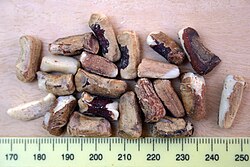Sclerocarya birrea
| Marula | |
|---|---|
| File:Sclerocarya birrea.JPG | |
| Scientific classification | |
| Kingdom: | |
| Division: | |
| Class: | |
| Order: | |
| Family: | |
| Genus: | |
| Species: | S. birrea
|
| Binomial name | |
| Sclerocarya birrea (A. Rich.) Hochst.
| |

The Marula (Sclerocarya birrea) (skleros hard, karya walnut in reference to the stone inside the fleshy drupe) is a medium-sized dioecious tree, indigenous to the miombo woodlands of Southern Africa and the Sudano-Sahelian range of West Africa. The tree is a single stemmed tree with a wide spreading crown. It is characterised by a grey mottled bark. The tree grows up to 18m tall mostly in low altitudes and open woodlands. The fruits are used in the liqueur Amarula. The distribution of this species throughout Africa has followed the Bantu in their migrations, as it has been an important item in their diet since time immemorial. When ripe, the fruits have a light yellow skin, with white flesh, rich in vitamin C - about 8 times the amount found in an orange - are succulent, tart with a strong turpentine flavour. Inside is a walnut-sized, thick-walled stone. These stones, when dry, expose the seeds by shedding 2 (sometimes 3) small circular plugs at one end. The seeds have a delicate nutty flavour and are much sought after, especially by small rodents who know to gnaw exactly where the plugs are located.
Common names: maroela (Afrikaans), Boran (Kenya) - didissa ; English - jelly plum, cat thorn, morula, cider tree, marula, maroola nut/plum; Hausa - dania; Kamba (Kenya) - muua; Kwangali - ufuongo; Lovedu - marula; Maasai (Kenya) - ol-mangwai; Meru (Kenya) - mura; Ndebele - iganu, ikanyi, umganu, umkano; Pedi [fruits] - lerula, marula; Pedi [tree] - morula, merula; Pokot (Kenya) - oruluo; Portuguese (Mozambique) - canhoeiro; Ronga (Mozambique) - ncanhi; Sebei (Kenya) - katetalum; Shangaan - nkanyi, inkanyi; Shona - mutsomo, mukwakwa, mushomo, muganu, mupfura; Shona [fruits] - pfura; Shona [tree] - mufura, mafuna, marula; Swahili, Diga (Kenya) - mngongo; Swati - umganu; Swazi - umganu; Tonga - tsua, tsula, umganu; Tswana - morula; Tugen (Kenya) - tololokwo; Zulu [fruits]- amaganu, [seeds] - umganu, [tree] - umganu.
Relationships: Belongs to the same family Anacardiaceae as the mango, cashew nut, pistachio and Rhus.
Uses
- The seed kernels are high in protein and fat with a subtle nutty flavour and constitute an important emergency food.
- Fruits are commonly eaten fresh or used to prepare juice, jelly and alcoholic drink.
- Marula oil, made from the seed kernel, is one of Africa’s greatest skin care oils. It is rich in antioxidants and oleic acid.
- Can be used to make Ethanol fuel for transportation.
- The bark is used both as treatment and a prophylaxis for malaria. The bark of the male or female tree is also used in regulating the sex of an unborn child.[citation needed] Gums exudates from the stem are mixed with water and soot to make ink by certain tribes in the region.
- The bark also yields a red-brown dye used in colouring traditional craft ware. The leaves are chewed upon to help indigestion and to treat heartburn.
- The fruit infusion is used to bathe tick-infested livestock. The fruit is regarded as a potent insecticide.
- The marula fruit is also eaten by various animals in Southern Africa. In the movie Animals Are Beautiful People by Jamie Uys, released in 1974, some scenes were shown where elephants, warthogs and monkeys got drunk from eating fermented marula fruit. Later research showed that these scenes were improbable and, in all probability, staged. Elephants would need a huge amount of fermented marulas to have any effect on them, and other animals prefer the ripe fruit. The amount of water drunk by elephants each day would also dilute the effect of the fruit to such an extent that they would not be affected by it.
- An infusion of the inner bark of the marula tree can be applied to scorpion stings and snake-bites to alleviate pain.
